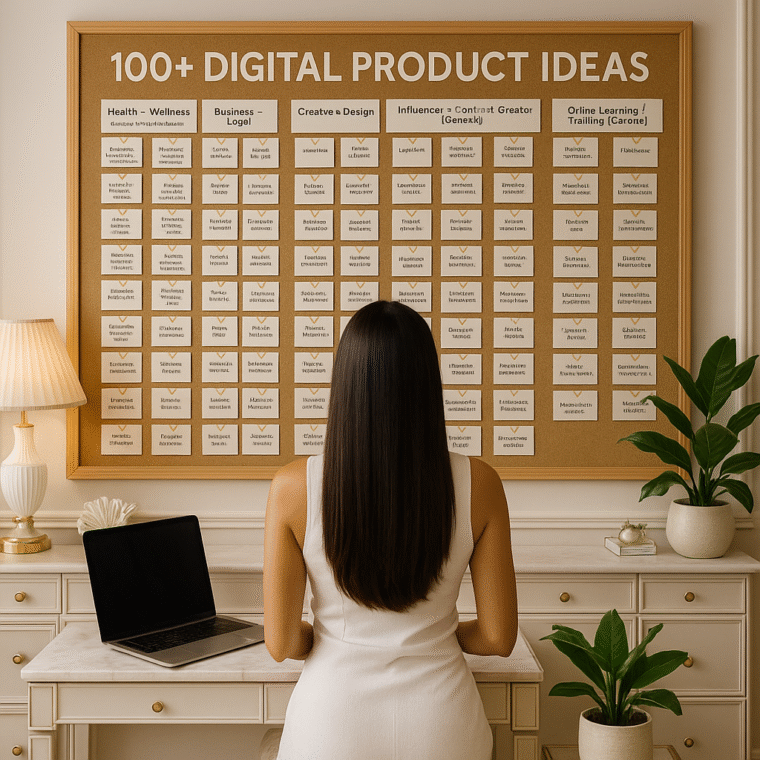How I Published 15+ Books Without Holding Any Inventory: The Power of Print-on-Demand
Imagine selling books in over 12 countries… without printing a single copy yourself, managing a warehouse, or ever dealing with shipping labels. That’s exactly how I built my publishing business — and it all runs on a model called Print-on-Demand (POD).
This isn’t just a publishing hack. It’s a significant shift in how content creators, authors, and many entrepreneurs can bring physical products to life without mass production. Whether you’re designing simple journals, printing art prints, or selling thematic T-shirts, POD makes it possible to run a product-based business with near-zero overhead.
In this article, I’ll walk you through:
- What Print-on-Demand actually is
- The types of products you can create
- Why POD is such a low-cost way to start
- How it compares to traditional outsourcing
- My personal story of publishing 15+ books with POD
- How influencers and creatives are monetizing with POD
- A list of top POD platforms for different niches
Let’s dive in.
What Is Print-on-Demand?
Print-on-Demand is a fulfillment method where products are only produced after an online customer places an order. You create the digital design — whether that’s a book, a T-shirt, a notebook, or a mug — and when someone buys it, the printing and shipping are handled automatically by a third-party provider.
You don’t need to buy inventory upfront. You don’t need to store anything in your garage. You don’t need to worry about international shipping. The entire process is streamlined and scalable — ideal for solo entrepreneurs, side hustlers, and creatives who want to build product lines without logistical headaches.
The Real Beauty of POD: You Can Start With Almost Zero Investment
One of the most empowering aspects of Print-on-Demand is how low the cost of getting started is. In most cases, the tools and platforms are free. You only pay a share of the sale after a customer places an order.
Example 1: Amazon KDP (Kindle Direct Publishing)
You can upload your manuscript, design a book cover, and publish a paperback on Amazon — all for free.
There are no upfront printing fees. When someone places an order for your book, Amazon prints and ships it, and you get paid a royalty.
I’ve published over 15 books using this method, and they’re now selling in 12+ countries — all without printing a single copy myself or holding inventory.
Example 2: Etsy + Printify or Printful
Etsy allows you to sell a wide range of items, from custom mugs and sweatshirts to journals. When you integrate it with a POD service like Printify or Printful, your Etsy store becomes an auto-pilot merch machine.
You upload your designs, and when someone orders, the product is printed, packed, and shipped by your POD partner, with no upfront cost and no shipping management.
You can start your own Etsy store today with just a few digital designs and have a physical product line ready to go by the weekend.
What Kind of Products Can You Sell With POD?
Print-on-Demand has evolved far beyond books. Here are popular product types:
| Category | Examples |
|---|---|
| Books & Notebooks | Paperbacks, planners, journals |
| Apparel | T-shirts, hoodies, baby clothes |
| Wall Art & Decor | Canvas prints, posters, tapestries |
| Home Goods | Mugs, pillows, coasters |
| Accessories | Tote bags, phone cases, laptop sleeves |
| Stationery | Stickers, greeting cards, calendars |
Some POD platforms also offer embroidery, hardcover books, candles, and organic products.
You create the idea or design — and the rest happens automatically.
POD vs. Traditional Outsourcing: What’s the Difference?
| Traditional Outsourcing | Print-on-Demand |
|---|---|
| Requires large upfront orders (MOQ) | Zero inventory needed |
| Must manage warehousing + fulfillment | Fulfillment is automated |
| Higher profit margins per unit | Lower risk and lower startup cost |
| Best for wholesale or retail distribution | Ideal for online sales and global reach |
| Long lead times, import logistics | Fast production, often local to the buyer |
In my fashion business, we deal with large volume production and logistics. But for my publishing company, I needed something lean, simple, and scalable — and POD changed everything.
How I Published 15+ Books on Amazon Using Print-on-Demand
When I launched my publishing company, I didn’t want to order 1000 books or guess what would sell. I wanted to test ideas fast and build a catalog over time.
Amazon KDP made it easy:
- I wrote and formatted my book using freelancers on Fiverr — I have a team of writers and cover designers on Fiverr.
- I uploaded the manuscript and created a simple cover using KDP’s templates.
- I selected Print-on-Demand — no inventory needed.
- When a customer orders, Amazon prints, packs, and ships the book.
I don’t touch a thing — and yet, those books are available globally and generating sales every week.
POD for Influencers, Creators & Side Hustlers
POD isn’t just for authors or designers — it’s a powerful tool for monetizing a personal brand.
Why Influencers Love POD:
- Merch drops with no inventory risk
- Design-led products aligned with their brand
- Fast turnarounds for seasonal or limited editions
- Digital + physical bundles (courses, coaching, merch)
Even with a small audience, creators can launch tote bags, T-shirts, or custom journals — with zero upfront investment. POD services integrate with platforms like Etsy, Shopify, and WooCommerce, making automation seamless.
Pros and Cons of the POD Model
✅ Pros:
- No upfront inventory cost
- Scalable from day one
- Sells globally without shipping coordination
- Low-risk product testing
- Hands-off fulfillment
- Accessible to almost anyone with Wi-Fi
❌ Cons:
- Lower profit margins per unit
- Limited control over packaging and materials
- Longer shipping times than Amazon Prime
- Less customization for complex products
For me, the tradeoff was worth it. Once a product gains traction, I can always transition to bulk production if needed.
Top Print-on-Demand Platforms (By Category)
| Platform | Best For | Notes |
|---|---|---|
| Amazon KDP | Books, journals, planners | Free to use, taps into global Amazon traffic |
| Printful | Apparel, accessories, decor | Great for branded stores and Etsy integration |
| Printify | Wide product range, global reach | Flexible pricing, strong integrations |
| BookBaby | Professional book publishing | Higher quality, higher production cost |
| Blurb | Photo books, design books | Ideal for creatives and visual artists |
| Gooten | Niche gifts, decor | Great for bulk and dropshipping |
| Zazzle | Creative gifts and printables | Built-in marketplace for discoverability |
| Redbubble | Art prints, pop-culture merch | Artist-focused platform with global audience |
Final Thoughts: POD Is the New Lean Creation Model
In a world where inventory and overhead can stifle creativity, Print-on-Demand offers freedom:
Freedom to test.
Freedom to create.
Freedom to grow without risk.
It’s how I built a book business that sells globally.
It’s how artists and side hustlers are building passive income.
It’s how influencers are launching merch — without managing a single box.
If you’ve ever dreamed of launching a product, but logistics held you back — start here.
Choose your idea.
Design with purpose.
Let the platform handle the rest.
You don’t need inventory. You just need initiative.
Your first sale could be a few clicks away.









